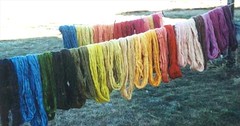The most difficult colours to dye are greens and very bright red, thus these colours were more expensive. Pure black and pure white were also very uncommon, where “black” is usually very dark with a brown or blue tinge and pure white can only be obtained through ', 'extensive treatment and sun bleaching.
A Viking black was created by mixing three of the most expensive dyes: cochineal, woad and weld. The Vikings also had their own method of creating brilliant white, however again it was very expensive.
If you are portraying a Byzantine peasant then you will wish to avoid purple. It was considered an imperial colour, and culturally only worn through special privilege and rank. A very wealthy Byzantine persona may consider wearing a small piece of purple cloth.
Other colours to avoid are very bright fluorescent colours; however some bright blues and yellows can be obtained. The image below demonstrates many colours that have been obtained using natural dyes that were available during the medieval period.
Dye Equivalent Colours
The following table highlight a selection of some of the more commonly known colours and a modern dye equivalent for obtaining this colour.
| Dye | Paterna | D.M.C. |
|---|---|---|
| Indigo from murex | 540 | 7319 |
| Shellfish (non-specific) | 300 | 7895 |
| Weld and alum and urine | 711 | 7784 |
| Weld | 760 | 7473 |
| Madder over Woad | 723 | 7767 |
| Madder | 861 | 7920 |
| Madder and alkali | 930 | 7184 |
| Madder and copper | 871 | 7446 |
| Woad | 524 | 7692 |
| Woad over weld | 691 | 7769 |
Additional Information
Black in Period
Craft of Natural Dying
Dye Equivalent Colours by Regia Anglorum
Medieval Dyes


No comments:
Post a Comment